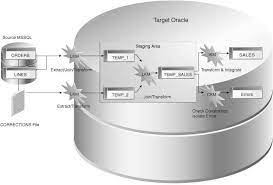To ensure efficient coding and maintenance in Oracle Data Integrator (ODI), consider the following tips:
- Standardize Naming Conventions:
- Adopt consistent naming conventions for ODI objects, such as models, interfaces, mappings, procedures, and variables.
- Use descriptive and meaningful names that reflect the purpose and functionality of each object.
- Consistent naming conventions help improve code readability and maintainability.
- Modularize Code:
- Break down complex mappings or interfaces into smaller, manageable modules.
- Use ODI submodels, reusable procedures, and packages to modularize code.
- Modular code promotes reusability, reduces duplication, and simplifies maintenance.
- Use ODI Best Practices and Design Patterns:
- Familiarize yourself with ODI best practices and design patterns.
- Follow recommended approaches for common scenarios, such as loading data from different sources, performing transformations, or handling errors.
- Leveraging established best practices can streamline development and maintenance processes.
- Comment Code:
- Add meaningful comments to your ODI code to explain the purpose, logic, and any complex transformations or business rules.
- Commenting code helps other developers understand your implementation and simplifies maintenance and troubleshooting efforts.
- Error Handling:
- Implement appropriate error handling mechanisms in your ODI interfaces and mappings.
- Use exception steps, conditional statements, and error tables to capture and handle errors gracefully.
- Proper error handling improves the reliability of your code and aids in troubleshooting and debugging.
- Use ODI Variables and Parameters:
- Utilize ODI variables and parameters to make your code more flexible and customizable.
- Define variables for dynamic values, such as database connections, file paths, or date parameters.
- Use parameters to allow users or administrators to input values at runtime, reducing the need for hardcoding.
- Regularly Test and Validate:
- Perform regular testing and validation of your ODI code and interfaces.
- Test data integration scenarios with sample data sets to ensure the expected results.
- Validate data integrity, transformations, and business rules during testing.
- Documentation:
- Maintain thorough and up-to-date documentation for your ODI code and processes.
- Document the purpose, logic, input/output, and dependencies of each interface, mapping, or procedure.
- Include any specific instructions or considerations for maintenance or troubleshooting.
- Version Control:
- Utilize a version control system (VCS) to manage your ODI code and track changes.
- Regularly commit your code to the VCS to maintain a history of modifications and enable collaboration.
- Use branches and tags to manage different versions and releases.
- Regular Code Reviews:
- Conduct regular code reviews with your team members or peers.
- Review each other’s code for adherence to coding standards, performance optimization, error handling, and maintainability.
- Code reviews help identify potential issues early on and promote knowledge sharing among team members.
By following these tips, you can ensure efficient ODI coding practices and facilitate smoother maintenance of your ODI solutions over time
SHARE
